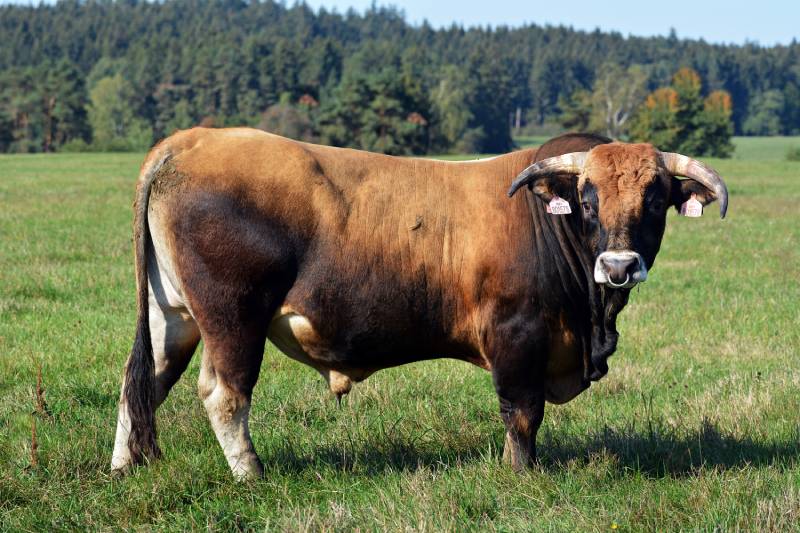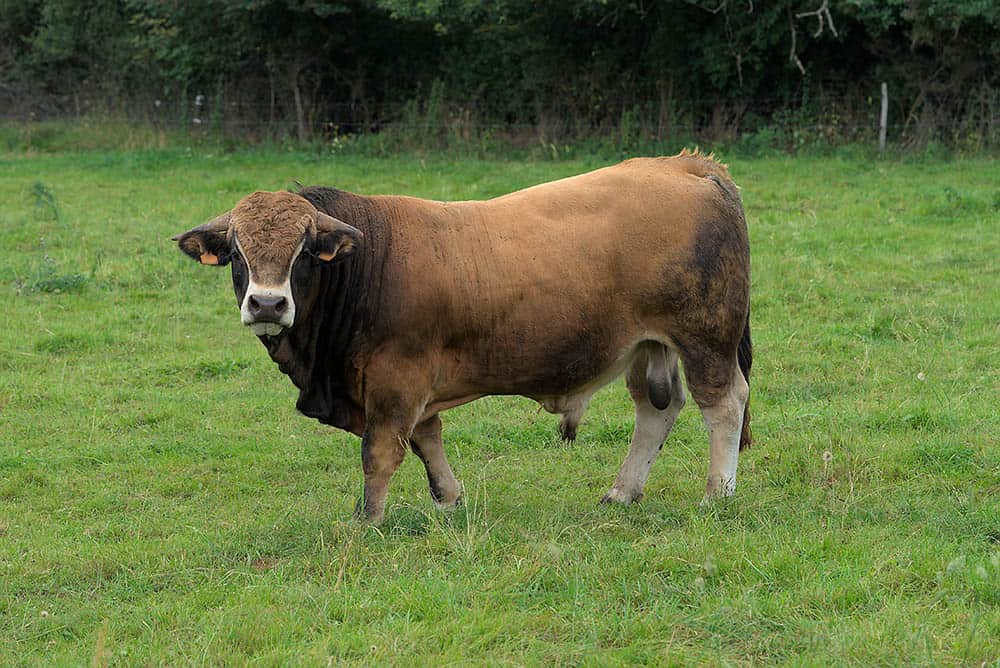If you’ve been looking for an excellent cow to produce delicious meat or milk, take a look at the Aubrac cattle breed! These cows are low-maintenance and cost-effective, making them a wonderful choice for farms. Plus, they produce meat known for its marbling and deliciousness. And though they are primarily used for meat these days, you can also use them as dairy cows.
Here’s what you should know about this cattle breed if you’re considering adding one to your farm.

Quick Facts About the Aubrac Cattle Breed
| Breed Name: | Aubrac |
| Place of Origin: | Southern France |
| Uses: | Meat, milk |
| Bull (Male) Size: | 1,819 lbs |
| Cow (Female) Size: | 1,279 lbs |
| Color: | Wheat, tan, fawn, brown |
| Lifespan: | 12 – 20 years |
| Climate Tolerance: | Most climates, but especially high altitudes, harsh climates, native climates |
| Care Level: | Beginner to intermediate |
| Production: | Excellent for meat, good for milk |
Aubrac Cattle Breed Origins

The Aubrac cattle breed originated in the 1600s at the Benedictine Abbey of Aubrac in southern France. There, monks practiced controlled breeding with Charolais blood, but this ended when the French Revolution destroyed the Abbey. The Aubrac breed, though, continued on and became extremely popular.
After the French Revolution, between 1840 and 1880, selective breeding occurred with the Brown Swiss to make the Aubrac breed even better. The herd book for the Aubrac breed was created in 1892.
The Aubrac breed first came to the United States in the 1970s; after that, they were imported twice more—in the early 1990s, then in the mid-1990s.
These cattle were originally bred for multiple purposes—draft, milk production, and meat production. However, over time the Aubrac cattle have had their main use reduced to just meat (some are still used for dairy, but meat production is much more abundant).

Aubrac Cattle Breed Characteristics
The Aubrac cattle breed is relatively low-maintenance and low-cost. Because they are originally from a mountainous region with harsher climates and used to be draft animals, the breed is extremely hardy and eager to work. They even enjoy exercise! Their draft animal history also gives them a sweet, docile temperament, making them easy to be around.
Their history of living in harsh mountains makes them excellent foragers who can find food in the toughest of terrains. The breed is also excellent at creating reserves during better times and utilizing them during lean times, which saves money. The Aubrac is also easy to keep in extremely cold climates, as they are nearly immune to the cold because of their background.
When it comes to calving, the Aubrac is incredibly fertile and enjoys calving ease. In fact, only 2% of cattle are taken out of productivity after the calving process. This ease is likely due to the wonderful pelvic conformation they have. The breed can also calve for a long time—even cows over 12 years of age have been known to still calve regularly. However, the downside is that though they have higher calving rates, this breed also has calf mortality rates that are higher.

Uses
Though the Aubrac cattle breed started out with multiple uses such as draft, milk, and meat, these days, they are mostly used for meat production. There are still some used for milk production, though. When it comes to milk, the Aubrac averages 559 gallons of milk per lactation. And this milk is of fairly good quality, with a butterfat content of about 4.3%.
The main purpose of the Aubrac, though, is meat production—meat that is known for its amazing flavor and tenderness. The meat of the Aubrac is dense with high marbling and a high bone to meat ratio. Their meat is consistently graded E and U, ensuring exceptional quality.
Appearance & Varieties
The Aubrac cattle breed is a breed that is medium in height, though they weigh anywhere between 1279-1819 pounds when mature. Though they have shorter legs, they are a sturdy, well-muscled cow built to endure mountainous climates and terrain. This breed is strong!
The color of the Aubrac is brown in color and includes shades of wheat, fawn, and tan. This color is darker on the shoulders (particularly in non-castrated bulls), as well as around the eyes and nose. However, their skin, hooves, tongue, muscle, the tuft of the tail, and nose are black.
Both cows and bulls will have horns shaped like a lyre that are fairly large. The horns will have black tips and should be pointed backward just slightly.

Population
There are about 10,000 Aubrac cattle throughout the world these days, with approximately 3,000 being in the French studbook and about 2,500 located in Germany. You can find this breed in around 15 countries, including France, Germany, Switzerland, Great Britain, Ireland, Spain, Lithuania, Austria, Hungary, Portugal, the United States, Italy, Canada, Belgium, Israel, and New Zealand.
Are Aubrac Cattle Good for Small-Scale Farming?
Because the Aubrac breed is so low-maintenance and cost-effective, they can do well on small-scale farms. Though not recommended for a first-time cattle owner, you should do fine so long as you’ve had a bit of experience with cows. You’ll require housing for them with adequate space and areas they can forage and graze. One great thing about the Aubrac breed is that they can eat low-cost, rough forage such as grass and hay and still produce quality meat and milk.

Conclusion
The Aubrac cattle breed is a popular one due to the excellent quality of meat they produce, along with their milking capabilities. The breed is also highly fertile, making for easier breeding. These cattle are fairly easy to keep and maintain as they can consume rough forage and still produce quality products. Plus, they are known for their hardiness and longevity. If you’re considering cattle, the Aubrac would be an excellent choice!
Featured Image Credit: Frederic Hodiesne, Shutterstock
